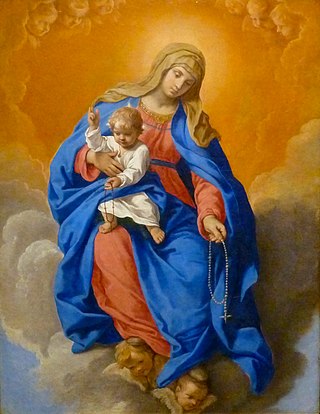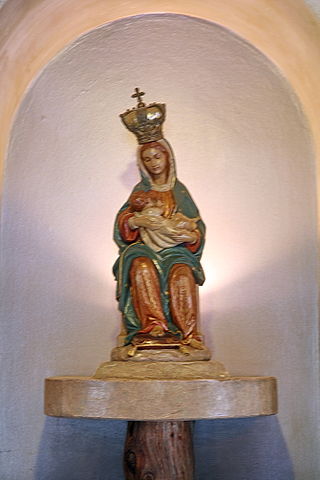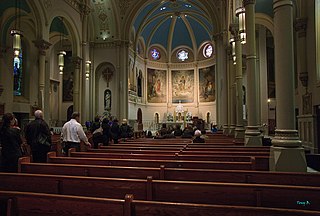
A shrine to the Virgin Mary, or Marian shrine, is a shrine marking an apparition or other miracle ascribed to the Blessed Virgin Mary, or a site on which is centered a historically strong Marian devotion. Such locales are often the destinations of Christian pilgrimages.

St. Augustine is a city in and the county seat of St. Johns County located 40 miles south of downtown Jacksonville. The city is on the Atlantic coast of northeastern Florida. Founded in 1565 by Spanish explorers, it is the oldest continuously inhabited European-established settlement in what is now the contiguous United States.

Walsingham is a civil parish in North Norfolk, England, famous for its religious shrines in honour of Mary, mother of Jesus. It also contains the ruins of two medieval monastic houses. Walsingham is 27 miles (43 km) northwest of Norwich.

Pedro Menéndez de Avilés was a Spanish admiral, explorer and conquistador from Avilés, in Asturias, Spain. He is notable for planning the first regular trans-oceanic convoys, which became known as the Spanish treasure fleet, and for founding St. Augustine, Florida, in 1565. This was the first successful European settlement in La Florida and the most significant city in the region for nearly three centuries.

Our Lady of Peace, Mother of Peace, Queen of Peace or Our Lady Queen of Peace is a title of the Blessed Virgin Mary in the Roman Catholic Church. She is represented in art holding a dove and an olive branch, symbols of peace. Her official memorial in the General Roman Calendar is on July 9 in the universal Church except for Hawaii and some churches in the United States, where it is kept on January 24.

The Diocese of St. Augustine is a Latin Church ecclesiastical territory of the Catholic Church, located in the northeastern section of Florida in the United States. It includes the cities of St. Augustine, Jacksonville, and Gainesville.

Our Lady of the Rosary, also known as Our Lady of the Holy Rosary, is a Marian title.

Beginning in the second half of the 16th century, the Kingdom of Spain established a number of missions throughout La Florida in order to convert the Native Americans to Christianity, to facilitate control of the area, and to prevent its colonization by other countries, in particular, England and France. Spanish Florida originally included much of what is now the Southeastern United States, although Spain never exercised long-term effective control over more than the northern part of what is now the State of Florida from present-day St. Augustine to the area around Tallahassee, southeastern Georgia, and some coastal settlements, such as Pensacola, Florida. A few short-lived missions were established in other locations, including Mission Santa Elena in present-day South Carolina, around the Florida peninsula, and in the interior of Georgia and Alabama.

The Spanish missions in Georgia comprised a series of religious outposts established by Spanish Catholics in order to spread the Christian doctrine among the Guale and various Timucua peoples in southeastern Georgia.
Joseph Patrick Hurley was an American prelate of the Roman Catholic Church. He served as bishop of the Diocese of St. Augustine in Florida from 1940 until his death in 1967.
Patrick Joseph Barry DD was an Irish-born prelate of the Roman Catholic Church. He served as bishop of the Diocese of St. Augustine in Florida from 1922 until his death in 1940.

Felipe de Jesús Estévez is a Cuban-born prelate of the Roman Catholic Church who was bishop of the Diocese of St. Augustine in Florida from 2011 to 2022. Estévez previously served as an auxiliary bishop of the Archdiocese of Miami in Florida from 2003 to 2011.
Francisco Pareja was a Franciscan missionary in Spanish Florida, where he was primarily assigned to San Juan del Puerto. The Spaniard became a spokesman for the Franciscan community to the Spanish and colonial governments, was a leader among the missionaries, and served as custodio for the community in Florida. After the Franciscan organization was promoted to a provincia (province), Pareja was elected by his fellow missionaries as provincial in 1616.

Our Lady of Europe is a title given to the Blessed Virgin Mary patroness of Gibraltar and protectress of Europe. The entire European continent was consecrated under the protection of Our Lady of Europe in the early 14th century from the Shrine in Gibraltar where devotion continues to this day, over 700 years on.

A Lourdes grotto is a replica of the grotto where the Lourdes apparitions occurred in 1858, in the town of Lourdes in France, now part of the sanctuary of Our Lady of Lourdes. Some Lourdes grottos are almost identical reproductions of the scene of the apparitions, with statues of Our Lady of Lourdes and Bernadette Soubirous in a natural or artificial cave, while others may differ from the original in size, shape or style.

St. Francis Barracks is a historic structure constructed of coquina stone located on Marine Street in St. Augustine, Florida, named in honor of St. Francis of Assisi. The barracks were constructed between 1724 and 1755 by friars of the Order of St. Francis, to replace a series of wooden buildings which had been destroyed by the ravages of the tropical climate in La Florida and by fire, both accidental fires and occasional intentional ones, such as when the city was razed by the English in 1702.

This is a list of replicas of Michelangelo's 1498–1499 statue, Pietà.

The National Shrine of Our Lady of La Leche is a Catholic Marian shrine located at the Nombre de Dios Mission in St. Augustine, Florida. Originally built in 1609 in honor of Our Lady of La Leche—a Marian apparition popular among the Spanish settlers in the area—it is the oldest shrine in the United States. It was elevated to national shrine status in 2019 and received a canonical coronation in 2021.

Our Lady of La Leche is a Catholic title of the Blessed Virgin Mary associated with a statue of her breastfeeding the infant Jesus Christ. It is said to be one of the oldest of all Marian devotions.

The Basilica Shrine of Our Lady of the Miraculous Medal, also known as The Miraculous Medal Shrine, is at 500 E. Chelten Ave. in the East Germantown neighborhood of Philadelphia, Pennsylvania. The church now known as the Basilica Shrine was founded by the Congregation of the Mission in 1879 as the Chapel of the Immaculate Conception on the grounds of St. Vincent's Seminary. In 1927, Fr. Joseph Skelly, CM, commissioned the creation of Mary's Central Shrine within the chapel to promote devotion to Our Lady of the Miraculous Medal, a title of the Virgin Mary originating with her apparitions to Saint Catherine Labouré in Paris in 1830.


















